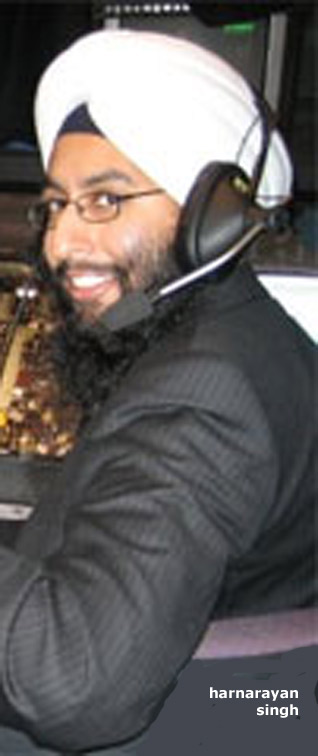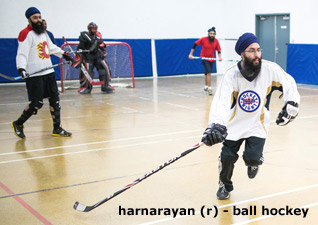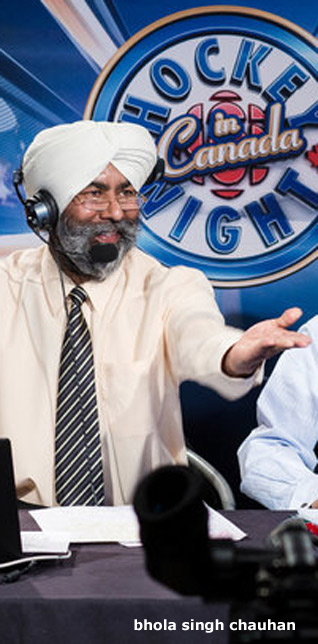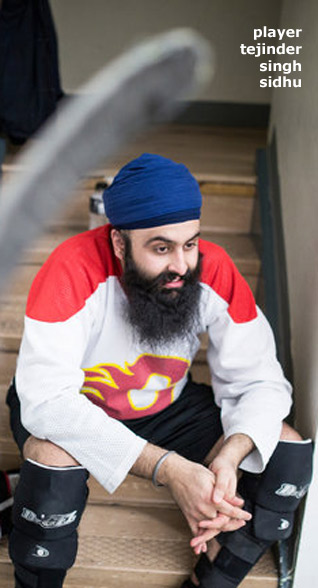Sports
Punjabi Broadcasts Draw New Ice Hockey Fans
DAVID SAX
Calgary, Alberta, Canada
Harnarayan Singh and Bhola Singh Chauhan sat at a desk in the CBC’s studio here last month, watching the first period of a game between the Toronto Maple Leafs and the Winnipeg Jets on two televisions.
Dressed in a pinstriped suit with gold cuff links, a blue-and-white tie and a matching turban, Harnarayan, a play-by-play announcer, called the end-to-end action in an animated stream of Punjabi, punctuated with English words like “linesman,” “icing” and “face-off.”
He spoke at great volume as Toronto scored its first goal, crediting wing Joffrey Lupul for what translates to “picking up the wood,” a traditional Punjabi battle cry akin to bringing the house down.
“Chak de phatte goooaaalll Joffrey Lupul! Torrronto Maple Putayyy!”
A few minutes later, Winnipeg’s Chris Thorburn and Toronto’s Colton Orr dropped their gloves and began pounding on each other, and Harnarayan rose in his chair to animate each blow.
As the players were led to the penalty box, Bhola Singh, a Punjab-born draftsman, writer and taxi driver wearing a cream-colored turban, read a fighting poem he had written based on a Punjabi style of verse.
The guy who is winning has a punch like a lion, and takes over the fight.
He hits like a sledgehammer.
They’re rivals, and he’s hung the other out to dry, not letting him go.
The weekly Punjabi broadcast of “Hockey Night in Canada,” as venerated an institution for Canadians as “Monday Night Football” is for Americans, is the only National Hockey League ("NHL") game called in a language other than English or French.
The broadcast marries Canada’s national pastime with the sounds and flavors of Punjab, providing a glimpse into the changing face of ice hockey.
Harnarayan Singh, 28, has developed a signature style tailored for his audience. A puck can be described as an “aloo tikki,” a potato pancake his mother makes especially well. When a team comes back in the second period with renewed energy, he might say what translates to “someone must have made them a good cup of chai in the intermission.” A player who celebrates after a big goal will “dance bhangra moves.”
Hockey players are overwhelmingly white in both Canada and the United States, and the diversity of the sport’s fans pales in comparison with those of baseball, basketball and football. The N.H.L. has one player of South Asian heritage, the Vancouver Canucks’ Manny Malhotra.
The number of children playing ice hockey in Canada has remained stagnant, said Paul Carson, vice president for hockey development with Hockey Canada.
“Growth in this country is coming from immigration from a lot of non-hockey-playing countries,” he said. “They’re coming from the Mideast, Africa, East and South Asia.”
The members of Harnarayan’s family, like most of Canada’s 1.1 million Punjabi speakers (almost twice as many as in the United States), are Sikhs. The religion is centered in the Punjab region, which straddles northwestern India and Pakistan. Sikhs have been in Canada since the late 19th century.
Harnarayan’s parents, Santokh and Surjit, were born in India and moved to Canada in the late 1960s, to work as teachers in Brooks, a small town in Alberta. Harnarayan, the youngest of their four children, was born in 1984, months after Wayne Gretzky and the Edmonton Oilers won their first Stanley Cup.
“These were the prime Gretzky years,” Harnarayan said. “I would set up a podium in the basement and do whole hockey awards shows. I’d sit in front of the TV and call games until everyone told me to shut up.”
Inderpreet Singh Cumo, a distant cousin who then lived in British Columbia, would sometimes visit, and they would narrate games together. Today, Inderpreet, 31, is a teacher in Calgary and shares the analyst role with Bhola Singh, 46.
By the time Harnarayan was 4, “all he was doing was remembering hockey,” his father said.
He added: “I told him: ‘You just have a hockey encyclopedia in your head. Nothing else!’ ”
Harnarayan said his obsession stemmed from hockey’s ability to act as an icebreaker with other children at school, where he was the only minority student.
“I wore hockey shirts,” he said, “because then I didn’t have to answer, ‘What is that thing on your head?’ ”
PRAYERS & HIGHLIGHTS
Over time, Harnarayan's fixation took over the family. A visitor to his home in northeast Calgary -- where he lives with his wife, Sukhjeet Kaur, a teacher; his parents; and his sister Gurdeep Kaur -- can expect to see a car with a vanity license plate based on Gretzky’s No. 99, a large television continually showing N.H.L. games or highlights, and closets stuffed with hockey jerseys.
Harnarayan’s recent wedding took place at a nearby rink, with hockey ticket invitations, a Stanley Cup cake and custom hockey cards with marital statistics. The couple had a photo session at the Saddledome, with Harnarayan in an Oilers jersey and Sukhjeet in a Flames jersey -- she is a longtime fan -- taunting each other from the penalty boxes. The ceremonial puck was dropped by the former N.H.L. goalie Kelly Hrudey, who is Harnarayan’s broadcasting mentor.
For every Sikh religious figure on the walls of the Singh-and-Kaur home, there is an equivalent picture of Gretzky nearby.
“Faith is a big part of our lives and a part of our everyday routine,” said Harnarayan, who wears a turban, keeps his beard long and plays the tabla, a percussion instrument, at a nearby gurdwara on weekends and during festivals. “Hockey is equivalent. I do my prayers religiously, and I watch highlights religiously.”
Harnarayan would make special prayer offerings on Gretzky’s birthday when he was a child, and the family schedules prayers and festival celebrations around game times. Even in the serene prayer room, the tissue box bears an Oilers logo.
Harnarayan, who has a degree in broadcasting, began working in televised professional hockey as an intern for the cable sports channel TSN when he was 19, and he also worked for CBC Calgary as a radio news reporter.
“Hockey Night in Canada” dropped into his lap in 2009, when Joel Darling, the executive producer of the show, asked Harnarayan if he would call a game in Punjabi.
Darling said that as a public broadcaster, CBC had a responsibility “to attract new Canadians and people who normally wouldn’t watch the sport of hockey.” In 2008, CBC broadcast the playoffs in Mandarin online and on a specialty channel. The next year, for a “Hockey Day in Canada” special, the network added Inuktitut, an Inuit language, and Punjabi.
“It just seemed to hit a groove, and all the right points seem to fit,” Darling said, explaining why Punjabi outlasted the other languages. “The community really opened their arms to it quickly.”
During his first two seasons with"Hockey Night," Harnarayan would work at CBC Calgary during the week to pay for his flight to Toronto on Friday. He would call the games Saturday night from CBC’s downtown headquarters, sleep on a relative’s couch and return to Calgary the next morning.
Even though it was exhausting, and required substantial support from his parents, he never complained to Darling or other members of the CBC staff because he feared they would replace him. (When they found out, they began paying for Harnarayan’s travel.)
Although the number of Punjabi viewers of “Hockey Night” remains a fraction of what CBC draws for its English and French broadcasts, the audience is growing quickly. Through mid-March, average online viewership had increased 45 percent per game since the 2011-12 regular season. Last year’s playoff games drew 229 percent more online viewers than the playoff games in 2011.
Television numbers are harder to come by, but Darling estimated that the TV audience might be five times as large as the online audience.
“A big part of the reason it caught on,” Darling said, “is because of Harnarayan.”
SLURS & TAUNTS
The transition in hockey’s culture has not always been smooth. In February, Nabil Karim and Gurdeep Singh Ahluwalia, both of whom come from South Asian-Canadian families, co-hosted “SportsCentre.” The broadcast drew a barrage of racist and xenophobic comments on social media.
“This was the first time we both hosted together, and the backlash was brutal,” said Karim, who had received similar comments after hosting hockey specials.
Harnarayan has endured barbs over the years, and it remains to be seen whether the wider hockey-watching public is ready to embrace a commentator with a beard and a turban.
“We’ve gotten comments from people who aren’t our viewers,” he said with a shrug. “Stuff like ‘What the hell do you know about hockey?’ and so on. But that’s a really tiny percentage of Canada. Not the majority.”
This week, Nail Yakupov, an Oilers wing from Russia who is one of the league’s two Muslim players, posted a message on Twitter that roughly translated to “How can this be?” and that was attached to a photo of Harnarayan in the broadcasting booth. The message and photo have since been removed ... after an apology.
Players have also been taunted with racial slurs in recent years, both by opponents and by fans. In a particularly ugly incident at a 2011 preseason game in London, Ontario, a banana landed on the ice as the Philadelphia Flyers’ Wayne Simmonds, who is black, skated toward the goal during a shootout.
Of the 717 players in the N.H.L. this season, only 69 are members of minorities, according to league statistics, including four Hispanics and Malhotra, the lone South Asian, who is out with an eye injury. Increasingly, high-profile minority players are coming up from the minor leagues, including several Sikh prospects, like Jujhar Singh Khaira, Sahir Singh Gill, Prab Singh Rai and Kevin Singh Sundher.
This year, three black players will most likely be early picks in the N.H.L. draft.
“We’re moving in the right direction,” said Willie O’Ree, the N.H.L.'s director of cause marketing, who in 1958 became the league’s first black player. “It’s not moving fast, but it’s moving in the right direction.”
O’Ree, who grew up in Canada, in New Brunswick, and now lives in California, said the biggest barriers to hockey’s diversification were access to ice and equipment for children from poor areas of cities and among immigrant populations.
So far, the best way to generate new fans seems to be having a successful home team. The Washington Capitals have broadened their appeal among young Hispanics and other minorities because of the star power of Alexander Ovechkin.
“Now there’s an explosion of interest in that community because they all want to play hockey,” said Peter Robinson, a Capitals official who oversees amateur hockey development. Local rinks are adding classes every week to keep up with demand, he said. “Their parents and grandparents didn’t pay attention to hockey, but now hockey’s everywhere.”
The N.H.L. and some individual teams see multilingual broadcasts as a valuable tool in attracting a more diverse fan base, although “Hockey Night” in Punjabi is the sole model. Ken Martin, who oversees diversity programming for the N.H.L., said the league would make a sustained effort to bring back Spanish-language broadcasts, especially in growing Hispanic markets like Phoenix, Chicago, and California. The Kings, whose fan base is 30 percent Hispanic, are considering reviving their Spanish broadcasts, which existed when Gretzky played for Los Angeles from 1988 to 1996.
The Punjabi presence in Canadian hockey has grown recently, especially in Vancouver. The Canucks’ run to the Stanley Cup finals in 2011 elicited bhangra tributes posted on YouTube, mass prayer vigils for the team’s success and spontaneous parades in the heavily Punjabi suburb Surrey.
That year, theaters in Canada, Punjab and India showed the film “Breakaway,” the story of a scrappy Sikh hockey team, the Speedy Singhs, and its skeptical coach, played by Hollywood's Rob Lowe.
Marc Crawford, a former Canucks coach, said of the Punjabi fans, “Their enthusiasm was unmatched.”
Crawford said he was frequently approached by women in colorful salwar-kameezes who would praise him and then deliver their opinions on line changes and trades.
“It was as though the one thing they really latched on to in the new country was the Canucks,” he said.
That enthusiasm is finally paying dividends for hockey development in Canadian cities with Punjabi populations as more children are taking up a game their immigrant parents, or grandparents, would never have considered. Although ball hockey is popular among Punjabis in Canada -- Harnarayan plays weekly -- few children make the transition onto skates.
Julien Endrody, the vice president for hockey development with Brampton Hockey, a league north of Toronto, said programs aimed at attracting children from immigrant or ethnic families had resulted in about a 20 percent increase in participation among Sikhs and other South Asians in the past two years.
“That’s our biggest growth demographic,” Endrody said, adding that the overall league enrollment had remained the same.
Many credit “Hockey Night” in Punjabi as a factor.
“This broadcast has really helped the Punjabi community to connect with the sport,” said Harbs Singh Bains, President of the Surrey Minor Hockey Association in British Columbia. “It allows someone whose first language is not English to connect with the sport and between generations.”
Harnarayan said many fans had told him that the broadcasts provided an instance for Punjab-born grandparents, who may not speak English, to get together with their Canadian grandchildren, who often do not speak Punjabi.
“Before we found out about the broadcast, my parents never watched hockey because they never understood it,” Simrandeep Singh Kaler, 17, of Brampton, wrote in an e-mail. “It is easier for them to understand the rules and regulation as well as how the game is played. It brings us closer together every Saturday night. It’s when we actually sit and watch TV together and enjoy what we’re watching.”
Kevin Singh Sundher, a Sikh who plays for the Rochester Americans in the Buffalo Sabres’ organization, said the Punjabi broadcast paved the way for aspiring players.
“That’s big because when you got the grandparents onside, you get the family onside,” he said. “They’re putting the kids in young, not waiting till they’re 13, 14.”
A SATURDAY NIGHT RITUAL
For the past two seasons, “Hockey Night in Canada” in Punjabi has been filmed in a Calgary studio, with Harnarayan calling back-to-back Saturday night games and either Bhola Singh or Inderpreet providing commentary. It is shown on specialty cable channels across the country and free to stream online. The show was suspended twice because of trouble in securing a sponsor, but it was brought back after intense lobbying by fans.
Chevrolet is the current sponsor.
Harnarayan spends each week preparing by methodically studying hockey. It is tricky to see players’ numbers from the televised feed, so he scrutinizes highlights to pick up their body language, and he reads every hockey article he can find. During the broadcast, he monitors the show’s Facebook page and Twitter stream, responding on the air to comments from viewers across the country.
Once the playoffs begin, he will cover a series each round all the way through.
As much as Harnarayan loves the Punjabi broadcast, he acknowledged that his dream was to eventually call games in English, his native tongue.
“It’d be a beautiful thing,” he said. “And nothing would spell multiculturalism in Canada better than having a visible minority on the broadcast.”
His bosses have no plans for such a move, which is fine with Harnarayan. As he prepared to start his fourth straight period of play-by-play, the Canucks and the Detroit Red Wings took the ice.
“If I did this for the rest of my career, I’d still be happy,” Harnarayan said with a smile. “I never even dreamt I’d ever get to this level. In the middle of a game, sometimes I’ll turn to Inderpreet and say, ‘Can you believe we’re actually doing this on “Hockey Night in Canada?" ’ ”
Vancouver scored off the first rush. “Chak de phatte Alex Burrows!” Harnarayan shouted. “Six seconds into the game, and what an amazing start!”
[Courtesy: New York Times. Edited for sikhchic.com]
April 27, 2013
Conversation about this article
1: Kanwarjeet Singh (USA), April 27, 2013, 3:24 PM.
I remember seeing the first ice hockey matches in India when ESPN started broadcasting almost all international sports events - the Stanley Cup, English Premier League soccer, Tour De France, US Golf Masters, Indoor cycling, martial arts competitions - a whole new world was opened up for us school-going kids in the early 90s. I was very surprised though why other Singhs did not enjoy ice hockey as much as I did - it is so much like field hockey - sure, it's a bit more aggressive but the idea is the same. I think we will be seeing more Sikhs (with full bana) in the league within this decade. It is such an exciting sport - meets the Punjabi profile completely - the excitement, the noise, the aggression, the zeal to win - all attributes of the Punjabi Sardar.
2: Sangat Singh (Kuala Lumpur, Malaysia), April 27, 2013, 8:26 PM.
Is there any department where Sikhs have not excelled, given just a tiny chance?






